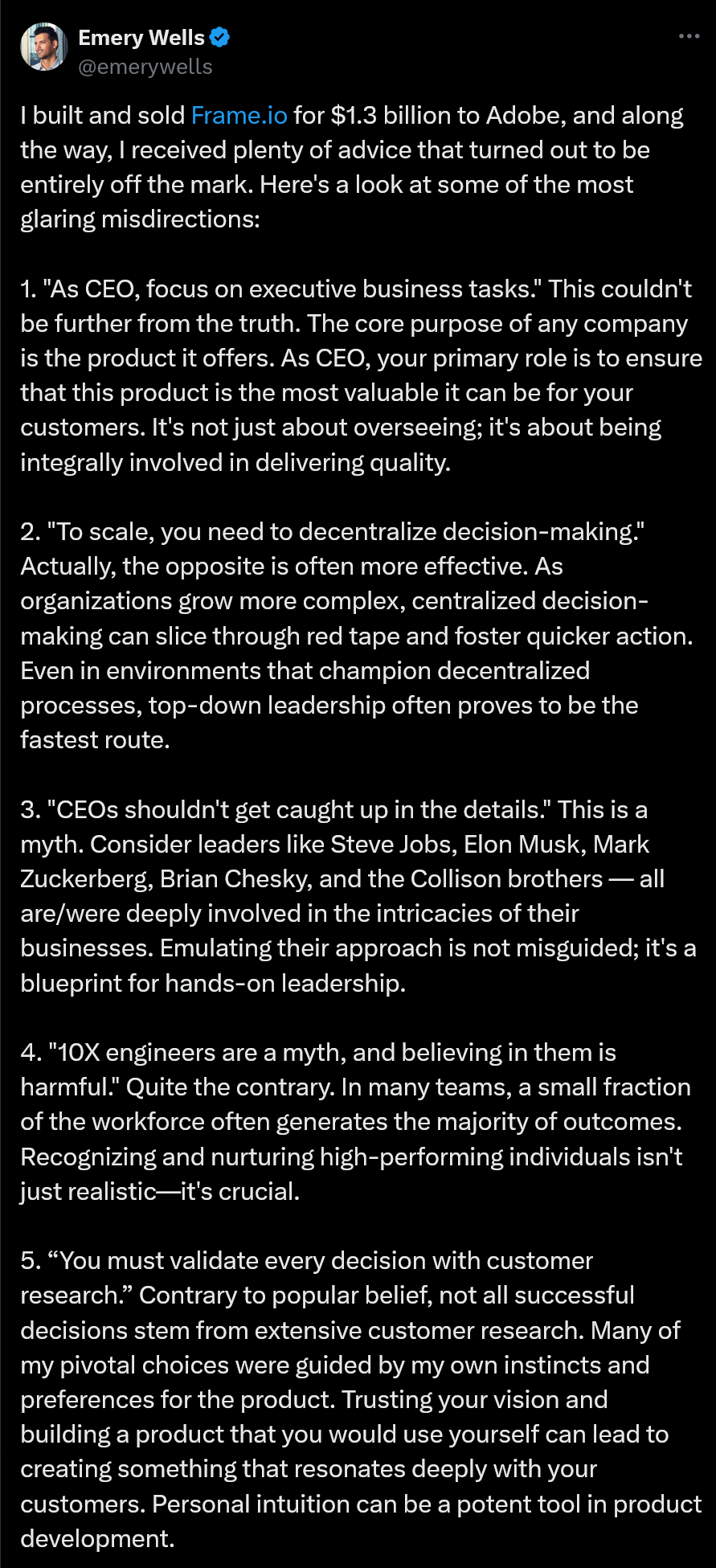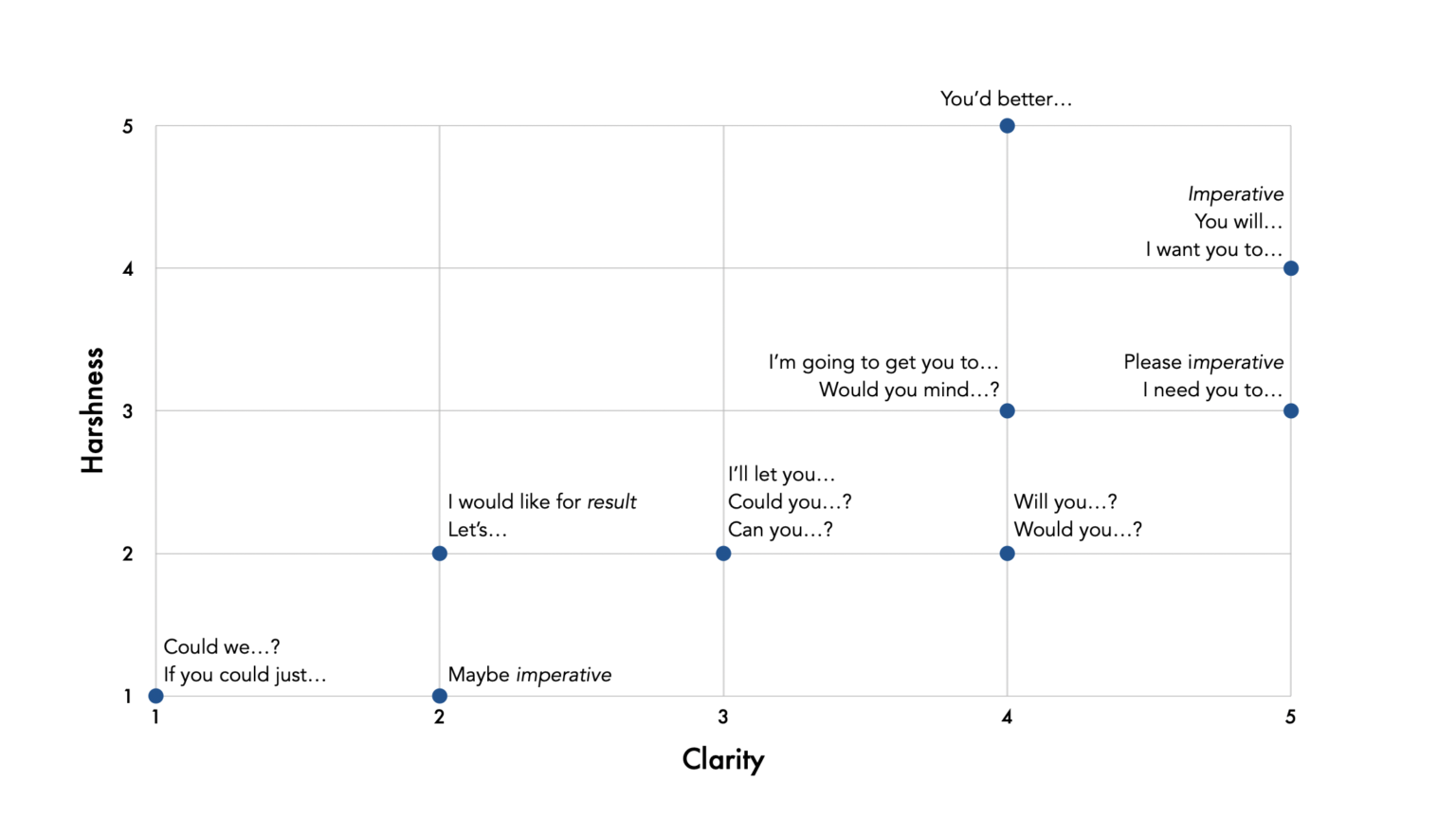If you only read one thingA Useful Productivity Measure? (11 minute read) “It’s always the productivity, always the f* productivity.” Nicky Santoro in the film Casino. Well he said dollars not productivity. But then again, where is the difference? From the article: “It started half a year ago, in September 2023. My CEO asked me how I was measuring productivity. I told him it wasn’t possible. He told me I was wrong. I took offense. It got heated.” I encourage everyone to own product impact, not development productivity. There is no way to win if you excell at productivity, they will always want more and more and more. And it is impossible to deliver. Assume “your” developers are 75% peak (say they are not average, and you did your job of making them productive). Now spend a lot of effort on productivity, and you go to 90% of peak productivity—something only very few orgs can do (Amdahl’s law applies). Your productivity only increased by 20% (!), something un-noticeable by anyone (especially your CEO, who has more than this on her table). So there is no way to succeed. (Dev productivity is a metric with an upper bound, marketing leads is a metric with no upper bound + Amdahl’s law doesn’t apply there, a crucial difference, which most CEOs do not understand - but explain it to your CEO nevertheless.) https://www.jamesshore.com/v2/blog/2024/a-useful-productivity-measure Tweet of the week
Source: https://twitter.com/emerywells/status/1783335501015203986 Picture of the week
Language! Source: How to Boss Without Being Bossy (17 minute read)
Stories I’ve enjoyed this weekThe Vision Pro is a big flop (11 minute read) I’m so old, I loved an Apple Newton (threw away my Palm). Which was a flop. And Apple had many bad products over the years, but they usually don’t release them. Except the Newton. The iPhone is just a smaller Newton. If the Vision Pro is a big flop, will there be a new version ten years on? Mass market Apple is bought because it makes you look good. Does the Vision Pro make you look good? Apple was never a great tech innovator, they took existing products and made them excellent (Laptop, iPhone, iPod,…) and desirable (The Newton failed because it wasn’t excellent). Seen this way, the Vision Pro makes an existing product (Rift) excellent, but is it desirable? The hyper growth of Apple came with things you can show around, not with the desktop at home. From this, a Vision Pro, that you can wear all day, and show around, will be what the iPhone was to the Newton. https://disconnect.blog/the-vision-pro-is-a-big-flop/ Made with ❤️ by ellipsis.dev (7 minute read) When I say software development will be gone in 20 years, people stare at me in disbelief. My karma tanks on HackerNews whenever I blurt that out. It is easier to understand when we talk about milestones. When will data teams go away (~5-10years), when QA and testing? This tool is one milestone, “Ellipsis is an AI devtool that reviews pull requests and converts GitHub comments into working, tested code.” (not a product endorsement). Development notes from xkcd’s ‘Machine’ (19 minute read) WOW WOW WOW what nice software, and an intriguing Goldberg machine and game. The development is a great example of how agile should work. You think, you experiment, you deep-think, you experiment and in the end come up with a great product. Agile is not putting an item on a roadmap, drawing something in Figma and push a Linear ticket to devs. Next. Read the article, build great things yourself. Developers and customers will be happy. So will your CEO. https://chromakode.com/post/xkcd-machine/ Managing High Performers (10 minute read) Who are your high performers? You might know if you’re a team lead, or a VP of Engineering, you might not know as a CTO of fifty people. Sure, two of them, but all of them? First, as an org, you need to identify high performers. Then, as the article goes into more detail, manage them correctly. We too often spend too much of our time with low performers instead of high performers. (+ your boss needs to know your high performers by name, makes promotion and salary increases much easier) https://staysaasy.com/startups/2024/05/08/managing-high-performers.html Copilotcalypse (3 minute read) Not sure if this is true in the end. I do think all of this will go away at some point, like turning off the lights, or creating a pivot table (I don’t want to have a pivot table, I want to solve a problem, if the AI solves the problem, I don’t need a pivot table in the first place. I often tell clients: If you had a magic lamp, would you really wish for a better pivot table?). But for a transition period, he is probably right: “I believe that we tend to overestimate our desire to talk to machines. Conversational interfaces can be great when you are exploring something unfamiliar, don’t have a device handy, or when you want to ask questions. However, they are inefficient and annoying when you are on a laptop or phone and know exactly what you want, from turning off the lights to creating a pivot table.” https://philcalcado.com/2024/03/08/copilotcalypse.html How Ahrefs Gets a Billion Dollar-Worth Infrastructure With a 90% Discount (8 minute read) Ten years ago I wrote on how the cloud is 10x more expensive than co-location. Now Ahrefs wrote how they have colocation costs of $122M vs. a projected cost of $1B if they had run it on AWS. Cloud is great when you start out, then when your growth plateaus, cloud is a huge cost, then it gets better again and when you’re large like Ahrefs, again it’s very expensive. So the story is cloud/no-cloud/cloud/no-cloud for many companies. Imagine what you could do with $1B that you didn’t give to Amazon. kaytu-io/kaytu (5 minute read) While we are on the topic of cloud costs: “Kaytu enables engineering, DevOps, and SRE teams to reduce [AWS] cloud costs by recommending optimal workload configurations based on actual-usage, ensuring savings without compromise.” When the crunch comes, be prepared to save. Know the tools. https://github.com/kaytu-io/kaytu Your 14-Day Free Trial Ain’t Gonna Cut It (7 minute read) Simple idea. Excellent idea. Higher chances for your success. Must read. https://keygen.sh/blog/your-14-day-free-trial-aint-gonna-cut-it/ React, Electron, and LLMs have a common purpose: the labour arbitrage theory of dev tool popularity (17 minute read) Interesting idea, “MongoDB’s popularity among managers during its peak was largely down to the idea that you no longer needed a database expert. Just throw the data into the document DB puddle and let your existing less-specialised developers handle it. […] Electron, PhoneGap, and React Native promised to let companies replace their expensive platform specialists with more commodified generalists.” Frameworks that succeed in the end are those that leverage labour arbitrage. From the tools you are using right now, which leverage labour arbitrage? (POSTGRES for everything! https://www.amazingcto.com/postgres-for-everything/ ) Which don’t? Now you know which ones will succeed and which ones you will replace in the future (Though as CTO I once replace Mongo with Postgres). https://www.baldurbjarnason.com/2024/react-electron-llms-labour-arbitrage/ You can’t summarize the most important parts of a book (11 minute read) Perhaps this is the reason Blinkist doesn’t work for me, “If you want a book to change you, you’ll need to do it the long, hard, stupid way.” The same goes for all experience, there is no real shortcut to experience. Ha, I’m a CTO coach selling short cuts. But even there, there is no shortcut to experience. To become me, you have to be 40 years in the industry (though I can get you out of some urgent problems you have right now, no time for 40 years of experience, and I can help you avoid some dead ends and jump over some traps :-) https://herbertlui.net/you-cant-summarize-the-most-important-parts-of-a-book/ Borrow checking, RC, GC, and the Eleven (!) Other Memory Safety Approaches (33 minute read) A very in depth discussion of garbage collection, reference counting, and other ways to manage memory. As someone who loves Go, but thinks the Go garbage collector is very bad, and loves borrow checking in Rust, but thinks the borrow checker is too much of a pain to use Rust (don’t use Rust!), an interesting technical read. https://verdagon.dev/grimoire/grimoire You’re Probably Working on a Doomed Project (15 minute read) Not very cheerful, but true “So, if your project is failing and your team is dysfunctional and the market doesn’t want what you’re building, just remember: what you’re experiencing is the norm.” https://siliconladders.com/p/youre-probably-working-on-a-doomed The “it” in AI models is the dataset. (9 minute read) We talk a lot about models, LLama, ChatGPT, Gemini, and not enough about data. The article claims that models don’t count, it’s the data you put in those models. To distinguish yourself from your competitors, it’s not the model you’re using, but the data to finetune the model. You have that unique data, right? Right? https://nonint.com/2023/06/10/the-it-in-ai-models-is-the-dataset/ Join the CTO newsletter! | |


